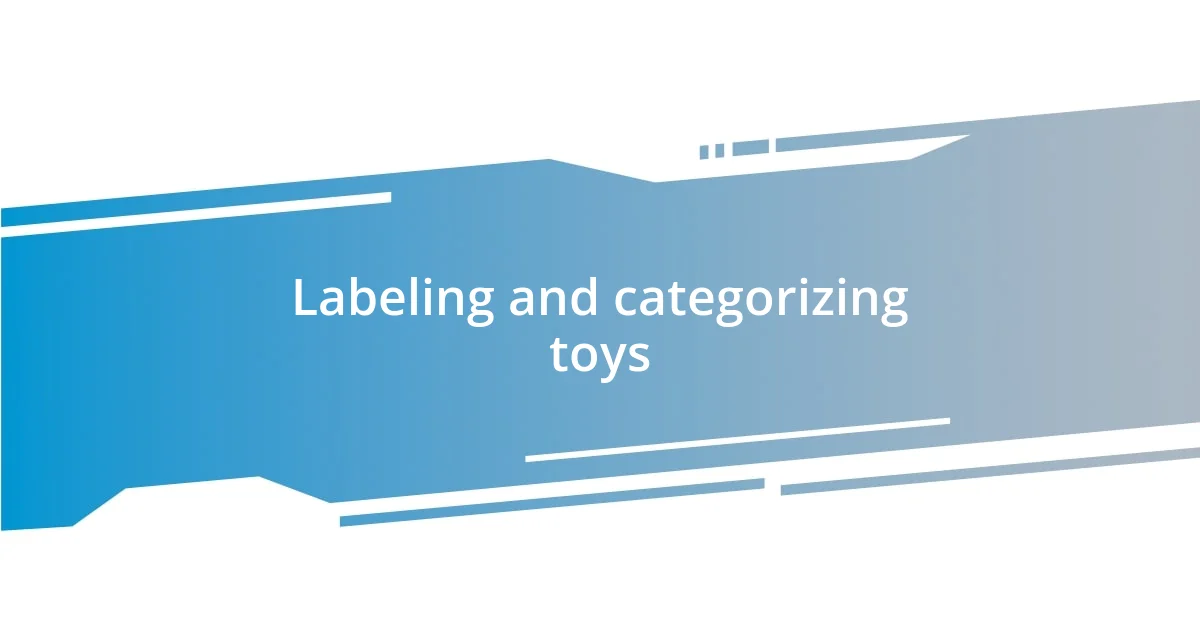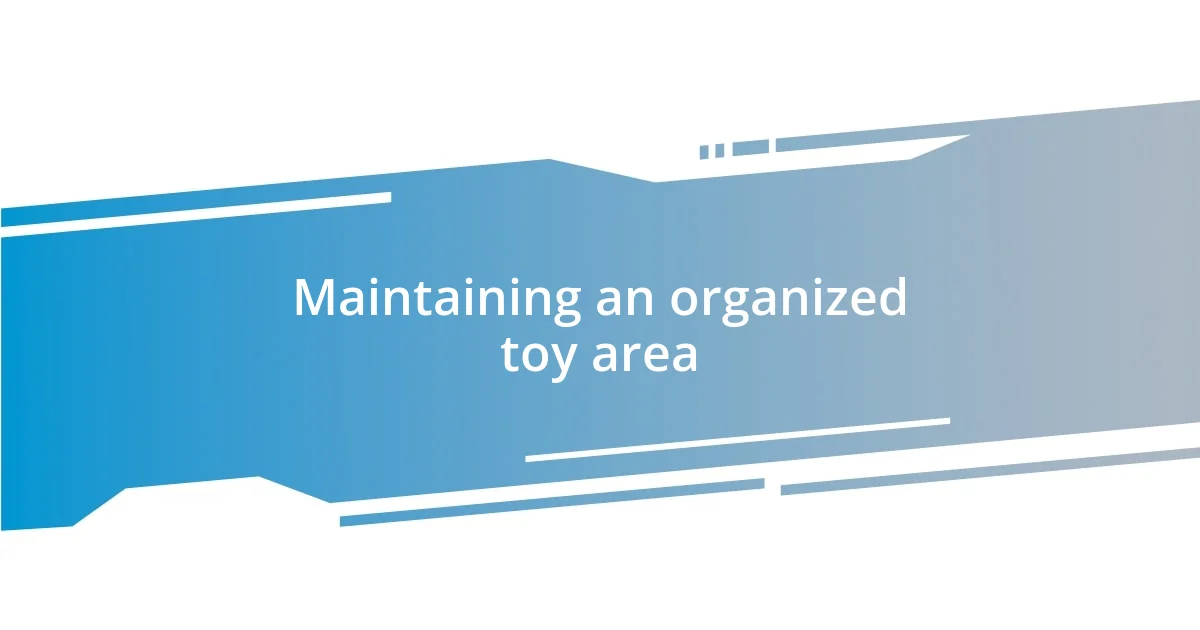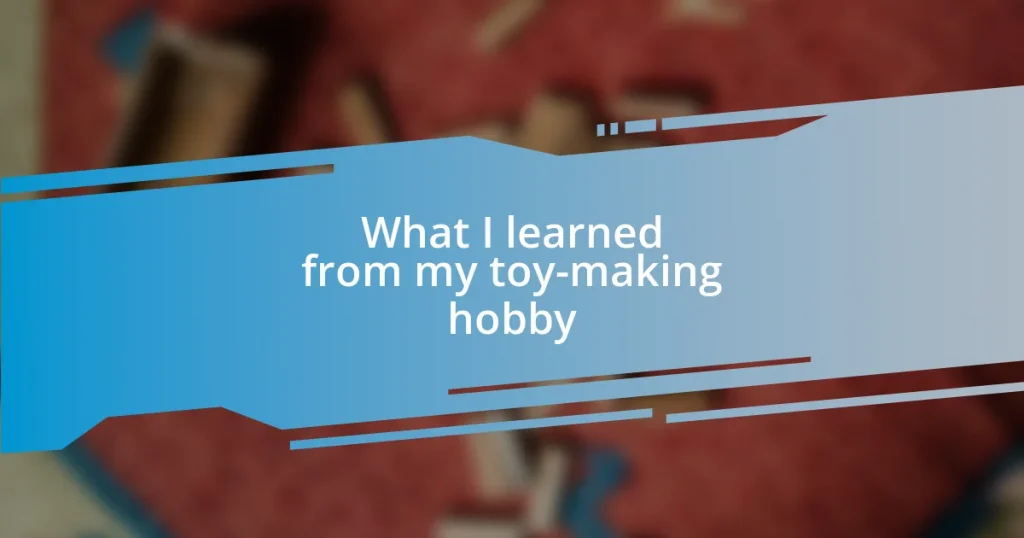Key takeaways:
- Understanding toy storage needs is linked to recognizing children’s developmental stages and ensuring accessibility, promoting creativity and independence while minimizing clutter.
- Choosing the right storage solutions, such as clear bins and low shelves, enhances organization and encourages children to take responsibility for their toys.
- Labeling and categorizing toys not only simplifies the cleanup process but also fosters creativity and learning, turning organization into an enjoyable family activity.

Understanding toy storage needs
Understanding toy storage needs often starts with recognizing the unique lifestyle and play habits of your family. I remember my own struggles when my kids were smaller—everywhere I turned, there seemed to be a new pile of toys. It made me wonder: how do other families manage to maintain order amidst all that chaos?
As I researched different storage solutions, I realized that it’s not just about finding space; it’s about accessibility and the age of your children. For instance, my toddler could never reach the high shelves where the “special” toys were stored, so those items became forgotten. In reflecting on this, I ask: how can we encourage creativity and independence while keeping clutter at bay? Understanding your children’s developmental stages can truly shape how you approach storage.
Additionally, I noticed that offering a variety of storage options can cater to different toy types. At one point, I adopted clear bins for my kids’ art supplies, making it easy for them to see and access what they wanted. It brought a sense of freedom to their playtime while allowing me to keep the various items organized. This goes back to the core question—how can we create a system that supports both functionality and fun?

Choosing the right storage solutions
When it comes to choosing the right storage solutions, I’ve learned that function should meet the needs of the space available. For example, I once used a decorative basket for my son’s stuffed animals. Initially, it was just a pretty accessory, but then I noticed how easy it made clean-up for him. He loved tossing the toys inside, and it transformed a daunting task into a game, which made my life a lot easier!
I often hear the debate about bins versus shelves, and honestly, each has its place. I found that low shelves worked wonders in my living room. My children could easily access their favorite books and toys without needing help, promoting a sense of independence. It’s fascinating how a simple adjustment can foster responsibility—and save your back from constant bending!
In my experience, labeling is an absolute game-changer. I once created a colorful chart for my daughter’s toy storage, which included pictures of the toys and corresponding bins. It didn’t just help her find what she wanted faster; it also turned organizing into a fun activity! These choices might seem small, but they made a remarkable difference in our daily routine, transforming chaos into harmony.
| Storage Solution | Pros |
|---|---|
| Bins | Easy to stack and store; can be labeled for identification |
| Open Shelves | Encourages independence; easy access for kids |
| Storage Ottomans | Versatile; doubles as seating and storage |
| Wall-Mounted Racks | Maximizes floor space; visually appealing |

Best types of toy organizers
In my journey through toy organization, I discovered that the type of organizer can truly set the stage for a smooth playtime experience. For instance, I once transitioned to clear, stackable bins for my kids’ building blocks. It not only made everything visible but also sparked my children’s imagination. They’d excitedly rummage through the bins, mixing and matching pieces, and I remember the joy on their faces as they dove into creativity without feeling overwhelmed.
Here’s what I believe are the best storage solutions based on my experiences:
– Clear Storage Bins: Perfect for visibility; kids can easily find and return items.
– Cubby Systems: Great for grouping similar toys; helps with organizing play zones.
– Rolling Carts: Easy to move around; excellent for craft supplies or art projects.
– Under-bed Storage: Utilizes otherwise wasted space; out of sight, yet accessible.
– Toy Chests: Classic option; can double as a bench for extra seating in play areas.
Each type of organizer feels like a piece of the puzzle when combating chaos. I recall when I first tried a wall-mounted rack for my daughter’s dolls. Initially skeptical, I change my mindset when I realized it not only saved floor space but also turned her room into a charming display. It was enchanting to watch her proudly show off her collection to friends, which added a layer of fun I hadn’t anticipated.
From my perspective, the right toy organizers can truly enhance creativity and independence while maintaining order. Reflecting back, I wish I had discovered these solutions sooner!

Labeling and categorizing toys
There’s something so satisfying about labeling and categorizing toys—it’s like giving each toy its own little home. I remember one rainy afternoon when I decided to tackle my kids’ toy chaos. Using simple masking tape and a marker, I labeled each bin with words and pictures. The excitement in my children’s eyes as they matched their toys to the correct bins was pure joy! Suddenly, cleaning up became a team sport rather than a chore, and we spent the afternoon laughing and organizing together.
In my experience, categorization makes a bigger impact than I ever anticipated. I found it helpful to sort toys by type; all the puzzles went in one bin, while the action figures had their own special spot. This approach not only tidied up the space but sparked my kids’ creativity. They started making up stories and games based on the categories. Have you ever seen a child’s imagination come alive because they knew exactly where to find their favorite toys? It’s remarkable how organization can unleash play!
One technique I particularly love is using color codes for labeling. Each category gets a different color, which makes it visually appealing and easy for kids to grasp. I recall how proud my son felt when he recognized his toys’ colors and learned to sort them by himself. Not only did it teach him organization skills, but it also reinforced color recognition! It’s moments like these that make me appreciate how labeling and categorizing toys can turn a messy playroom into a haven of creativity and learning. Isn’t it exciting to think about the endless possibilities that come from a little bit of organization?

Maintaining an organized toy area
Maintaining an organized toy area is like nurturing a little ecosystem of creativity. Just the other day, I noticed my children becoming overwhelmed by their toy collection, which was a stark reminder of why organization matters. I took a deep breath and decided to dedicate a weekend afternoon to reshaping their play space. As I organized the toys, I couldn’t help but feel a surge of pride watching my kids help put things in their proper places. There’s something liberating about turning chaos into order, isn’t there?
One method that has worked wonders for me is creating dedicated zones for different types of play. By setting aside specific areas for building, art, and imaginative play, I’ve turned our playroom into a vibrant landscape of creativity. I remember that moment when my daughter excitedly dashed to the craft corner, inspired to create, all because everything was easily accessible. It made me realize—how can children thrive in their play if their toys are scattered and disorganized?
Equally important is the upkeep of the organization system. I discovered that dedicating just a few minutes after playtime to tidy up keeps the momentum going. When we all pitch in, the bonding time becomes just as special as the play itself. I can’t tell you how heartwarming it was to hear my youngest proclaim, “Let’s clean up together!”—it turned into a mini celebration. Have you experienced that joyous transformation from mess to order? Maintaining organization isn’t just about neat spaces; it’s about fostering a collaborative spirit and creativity in our homes.













